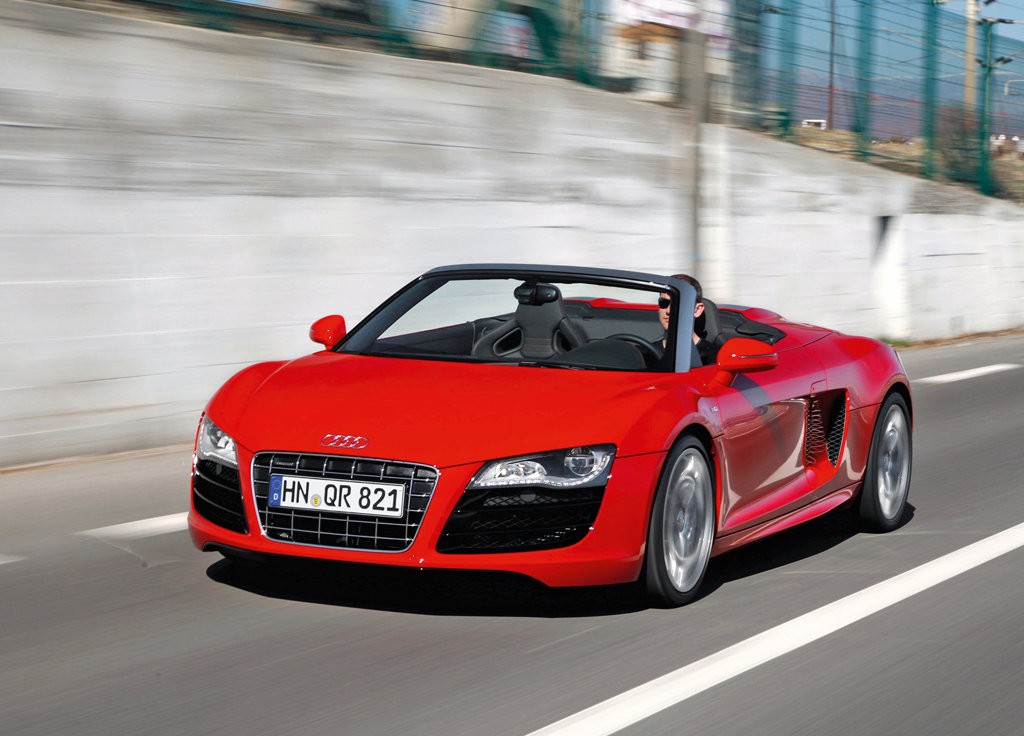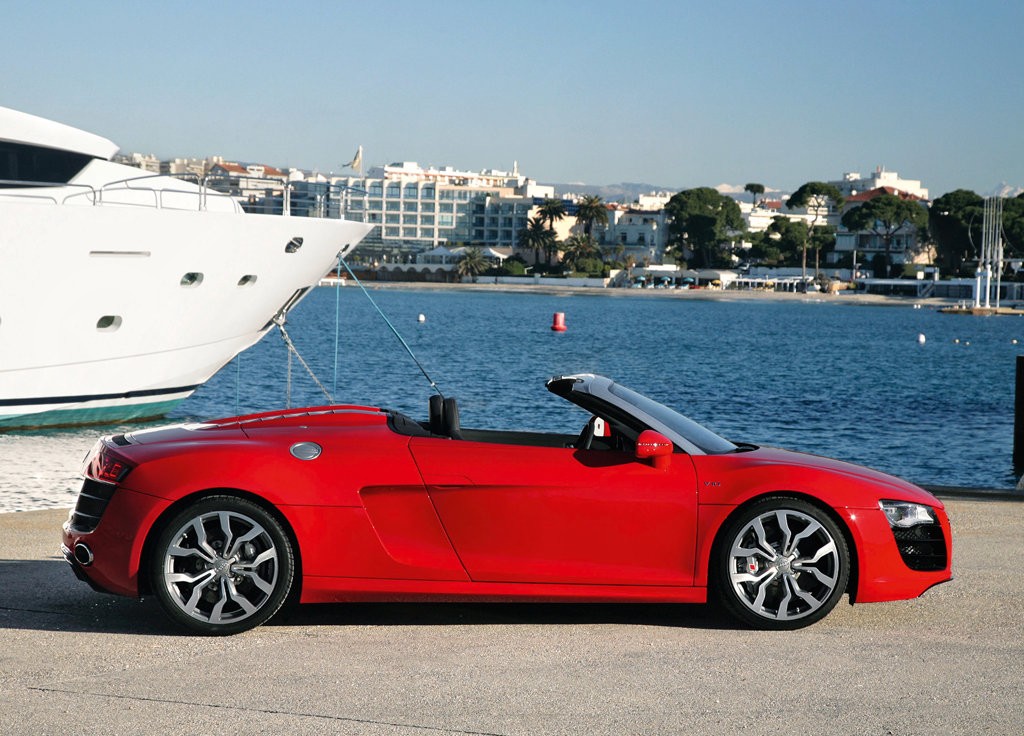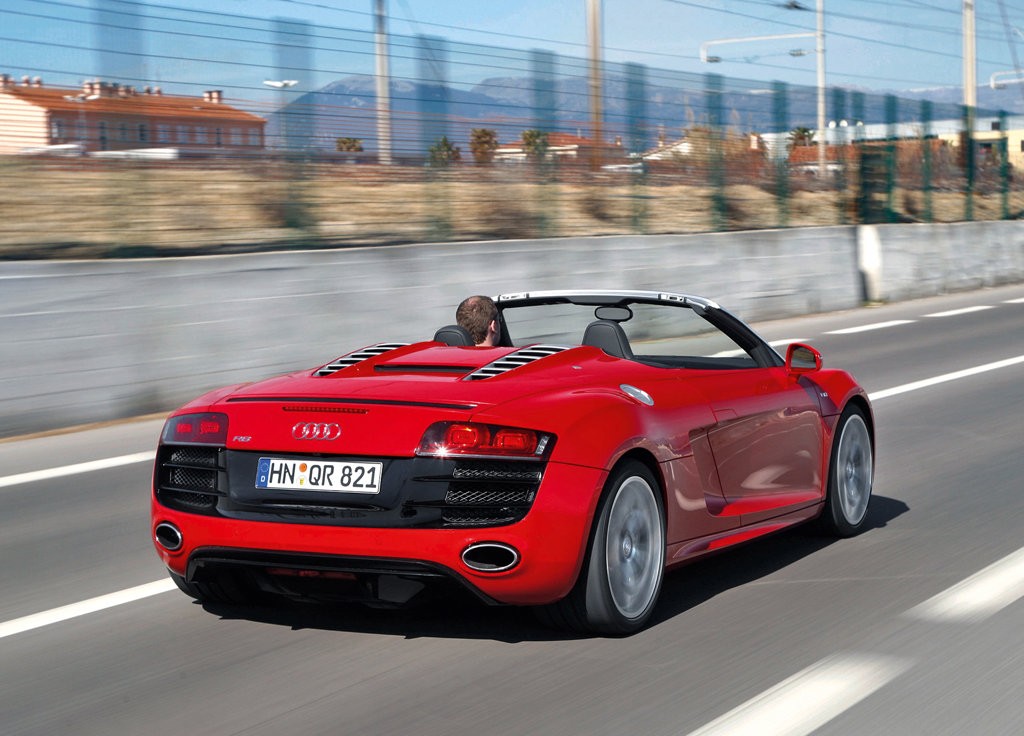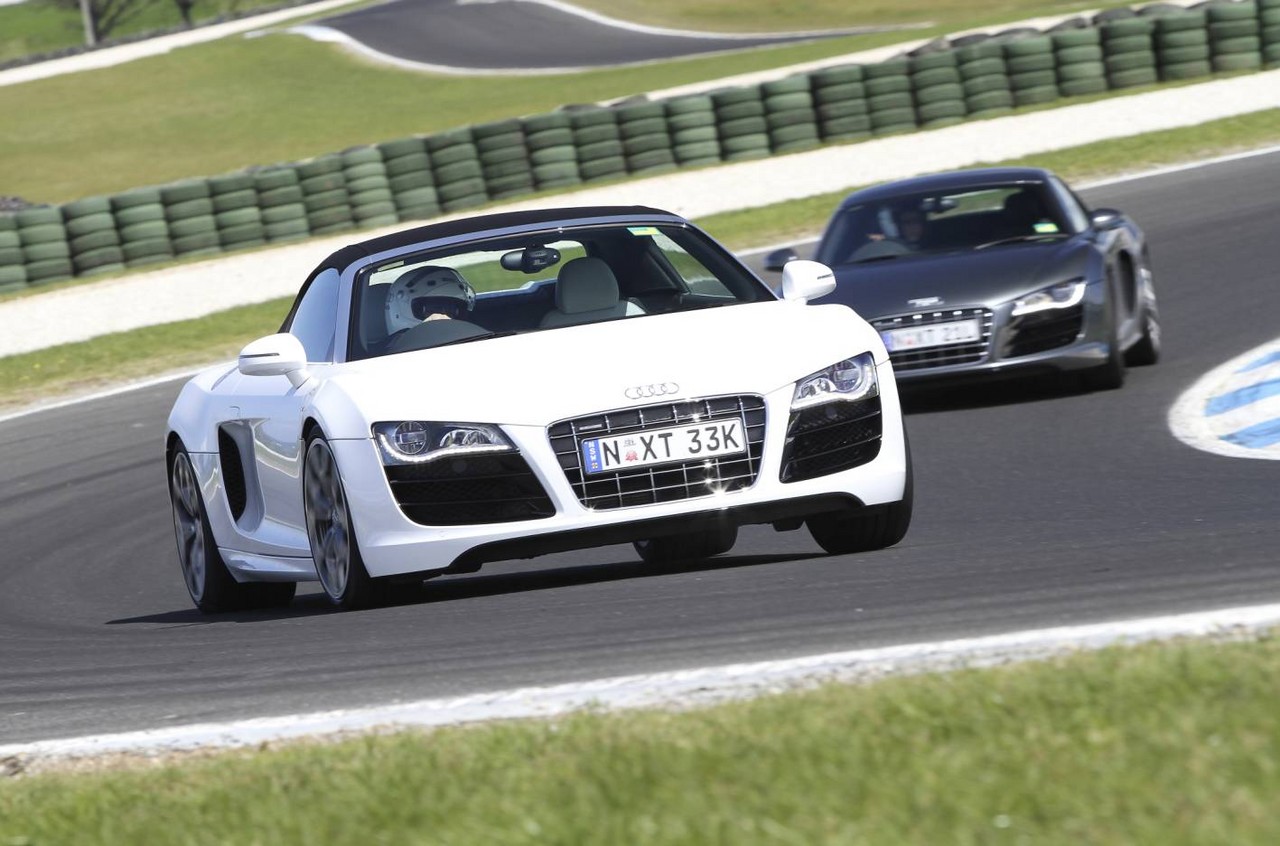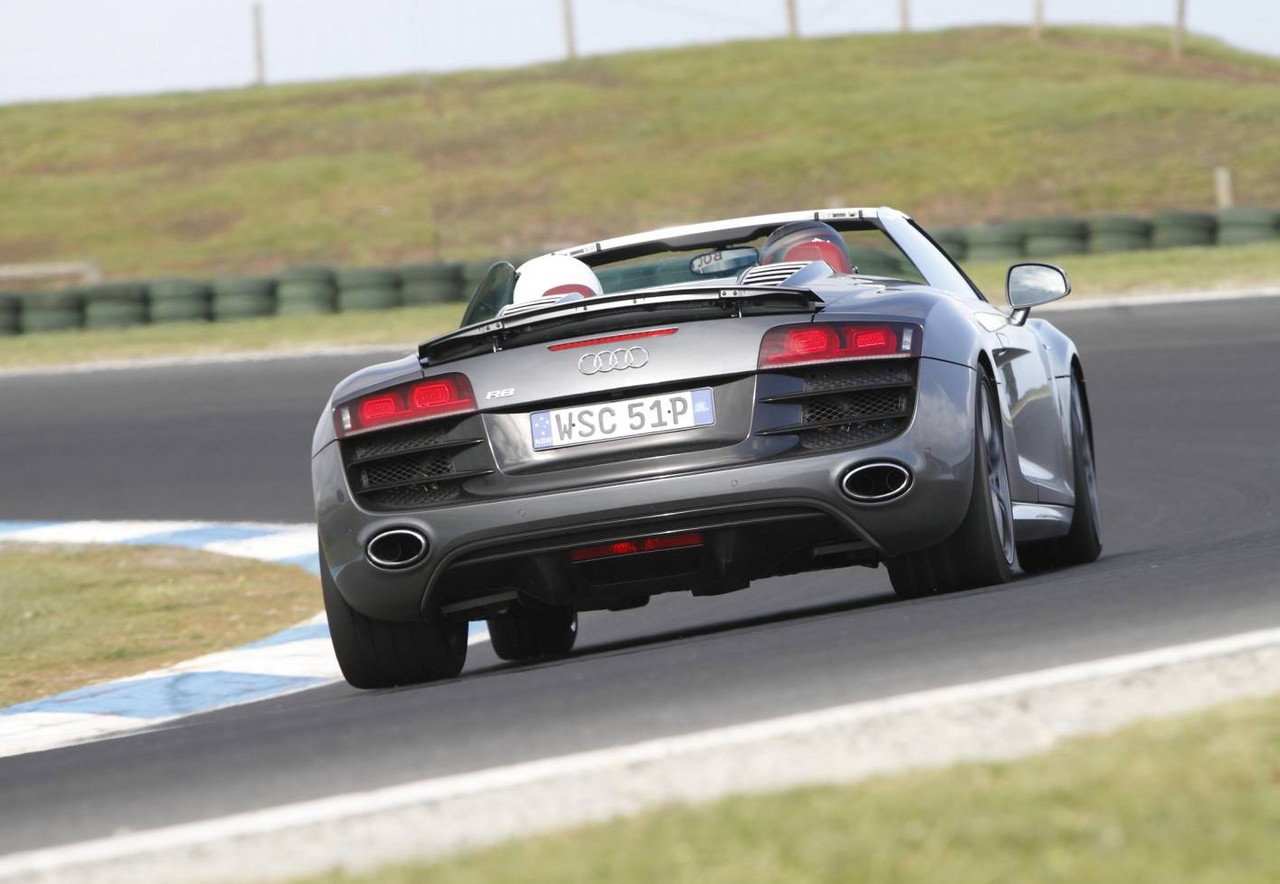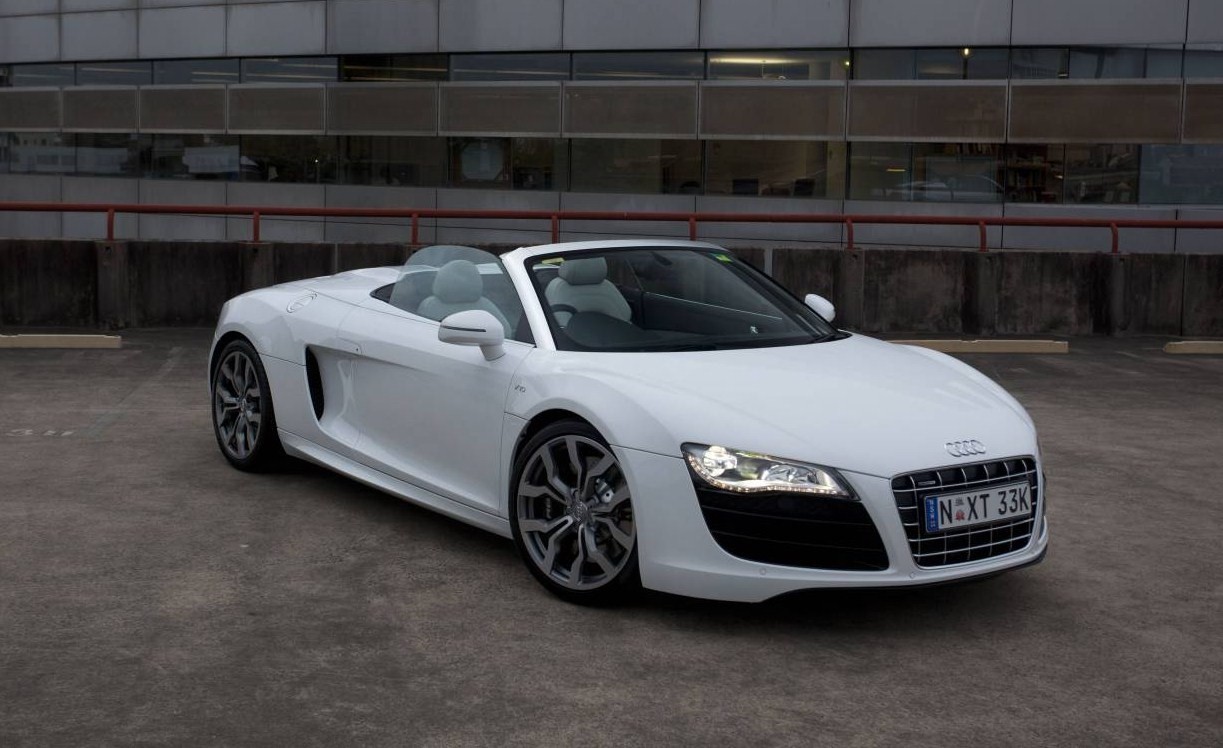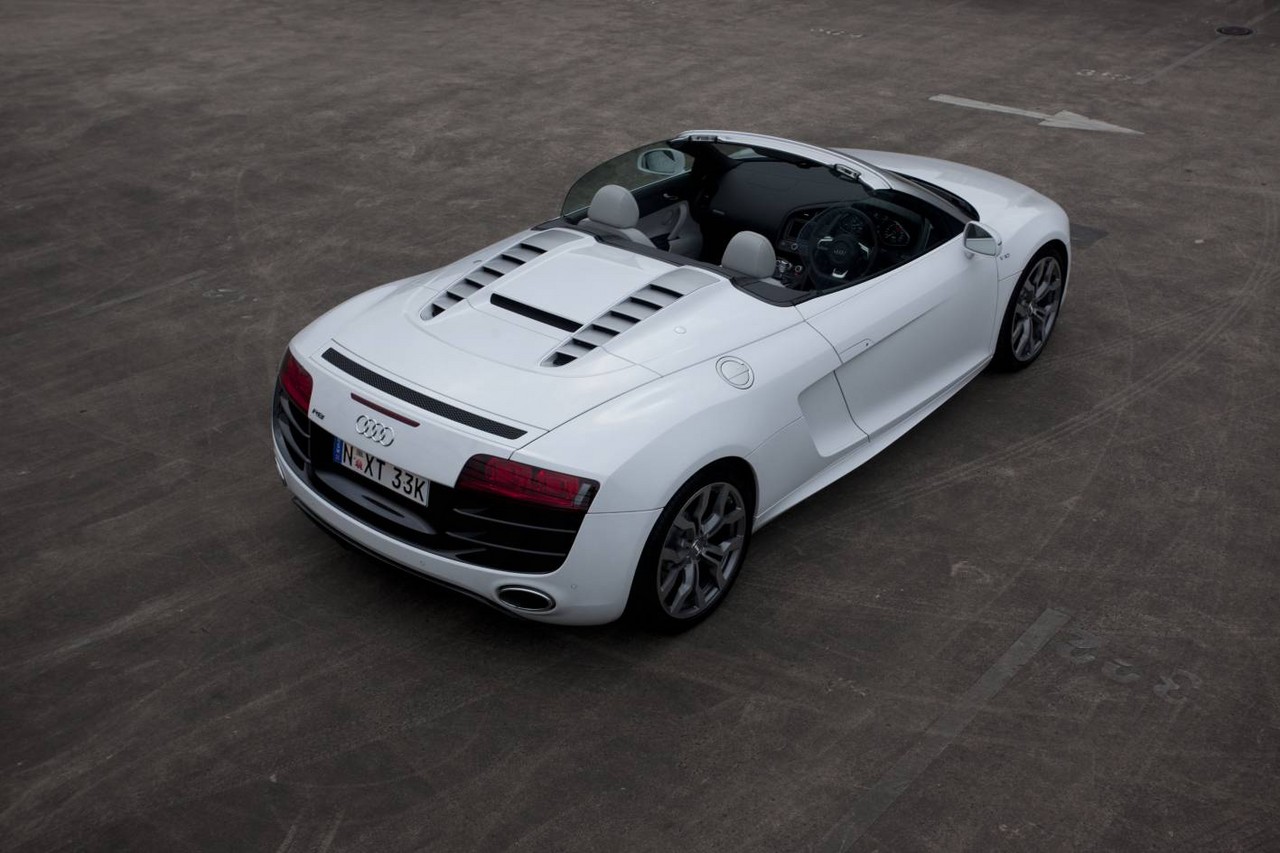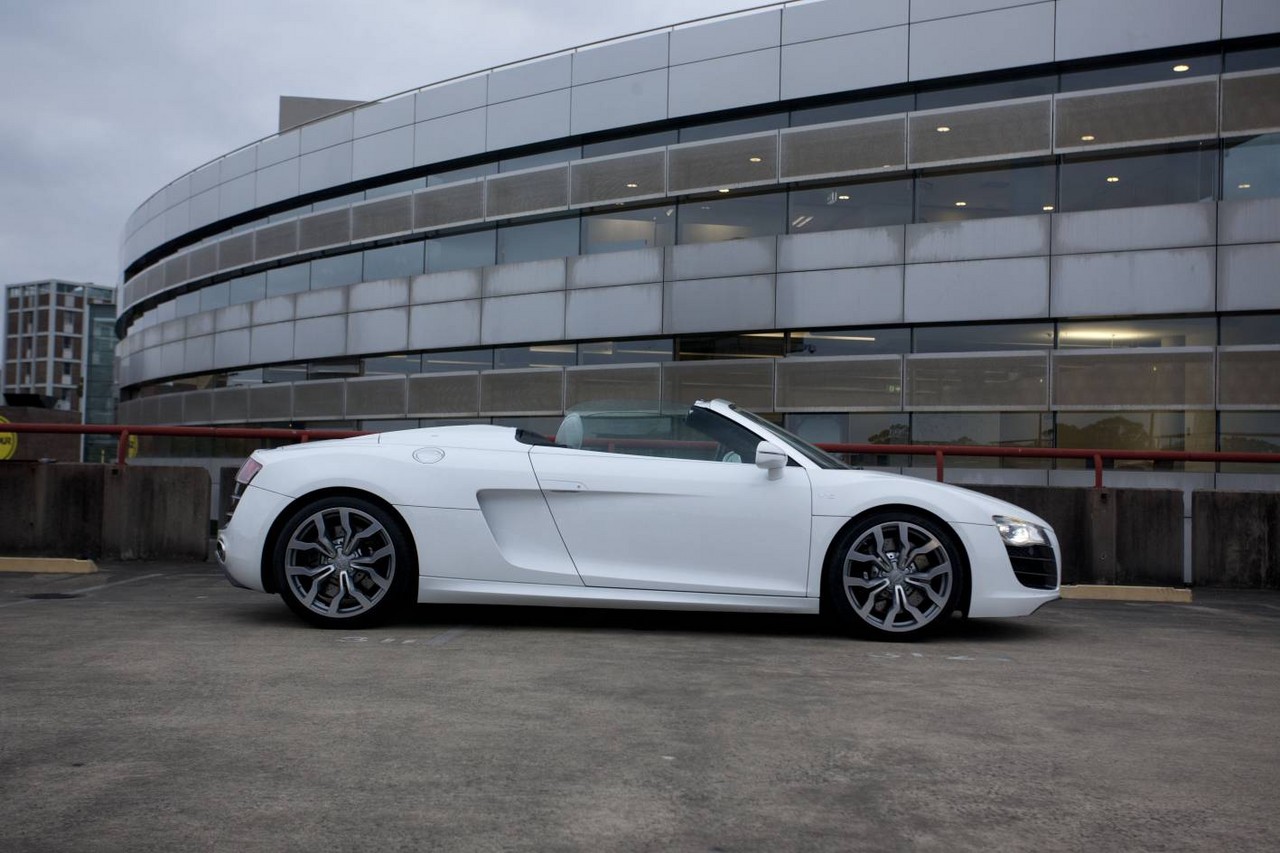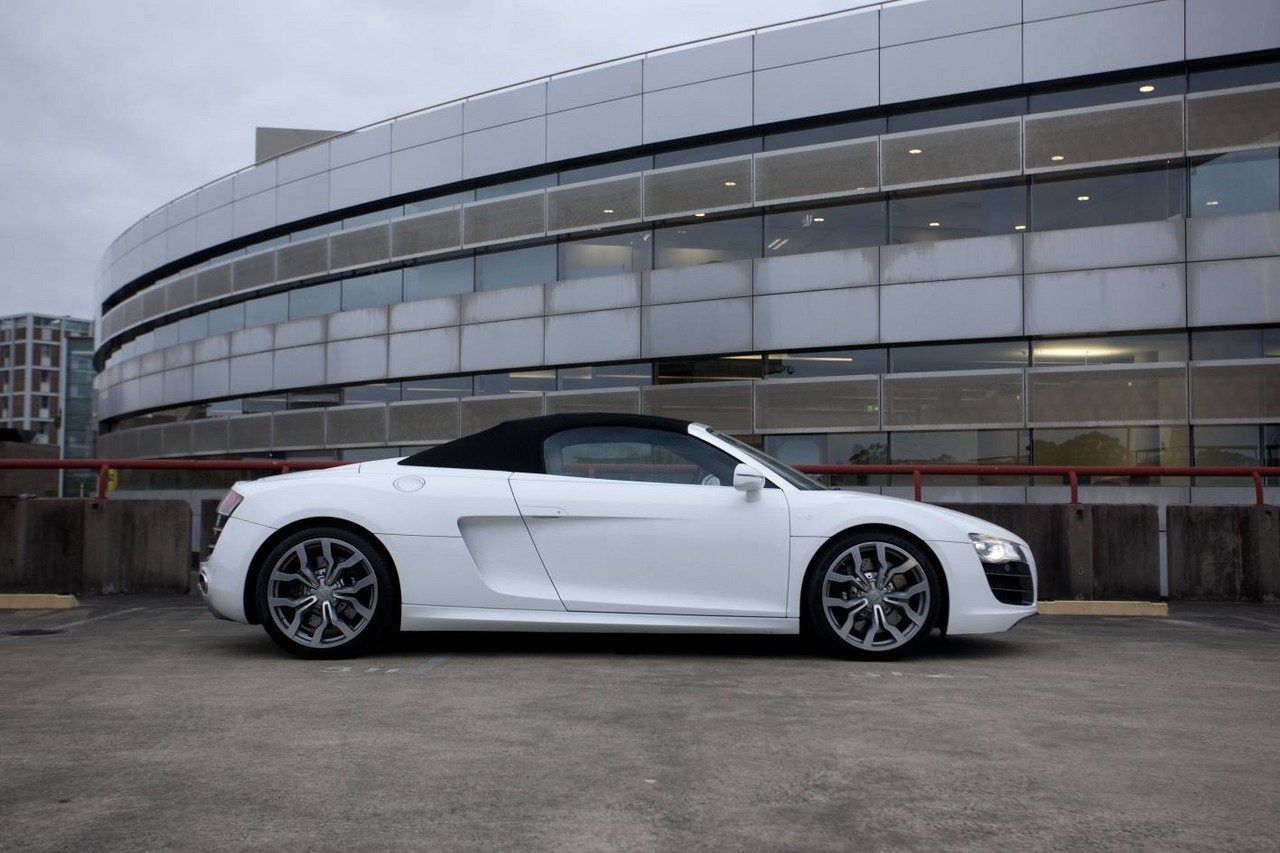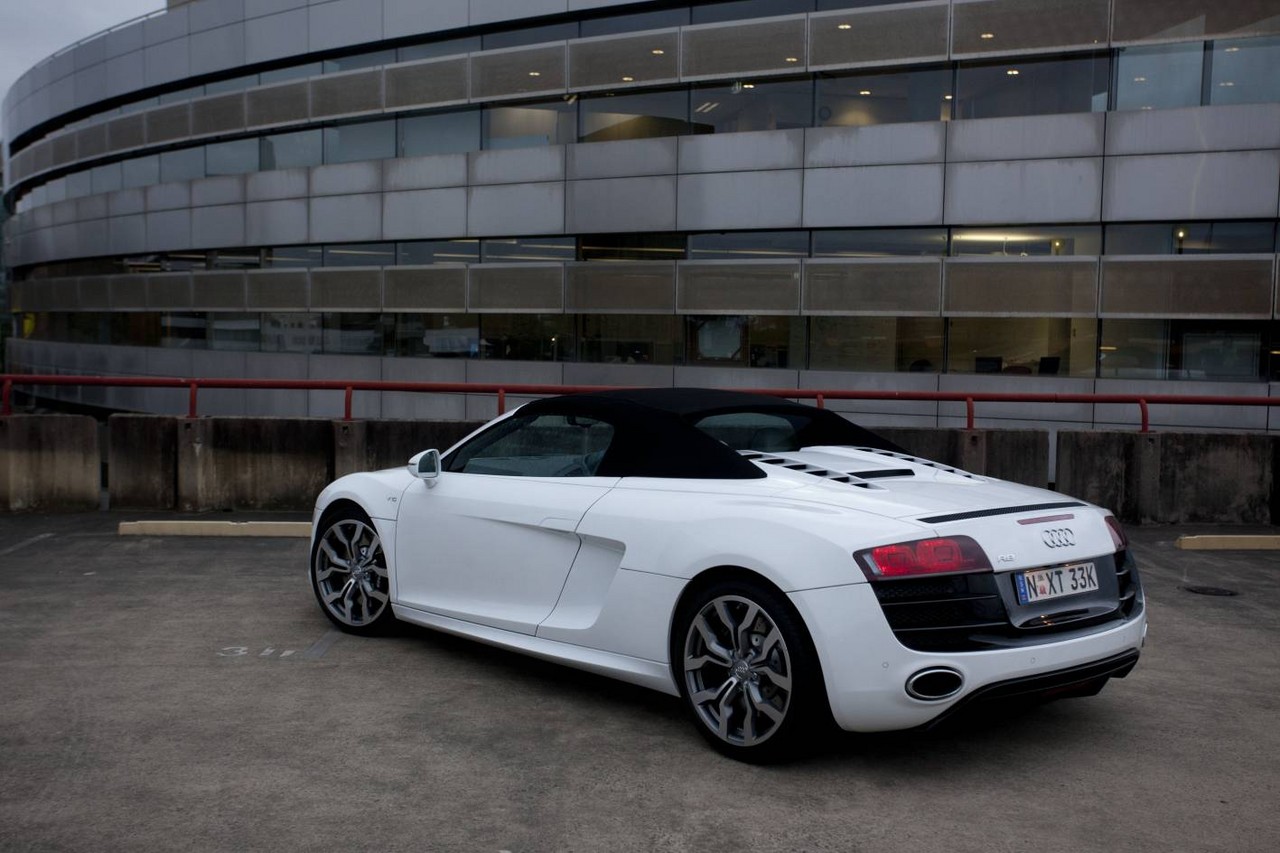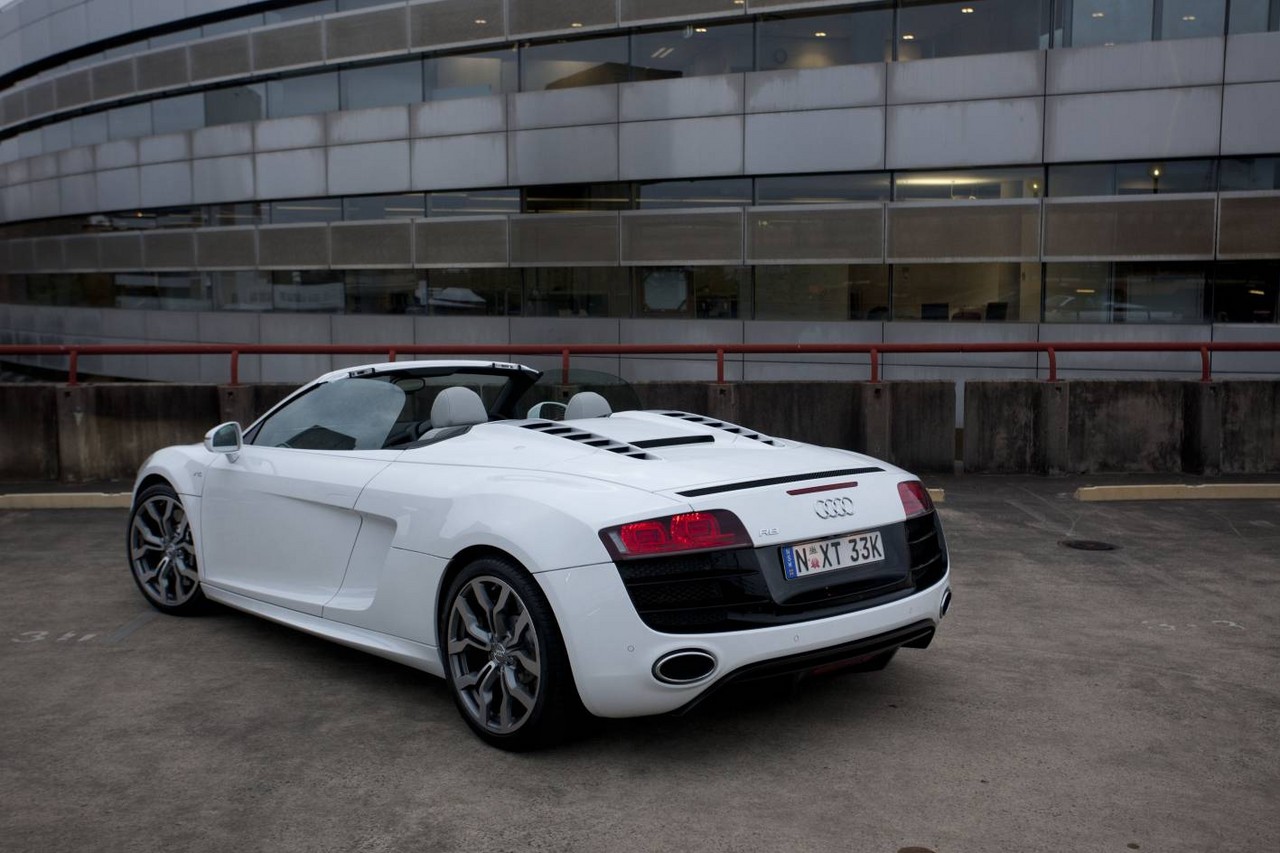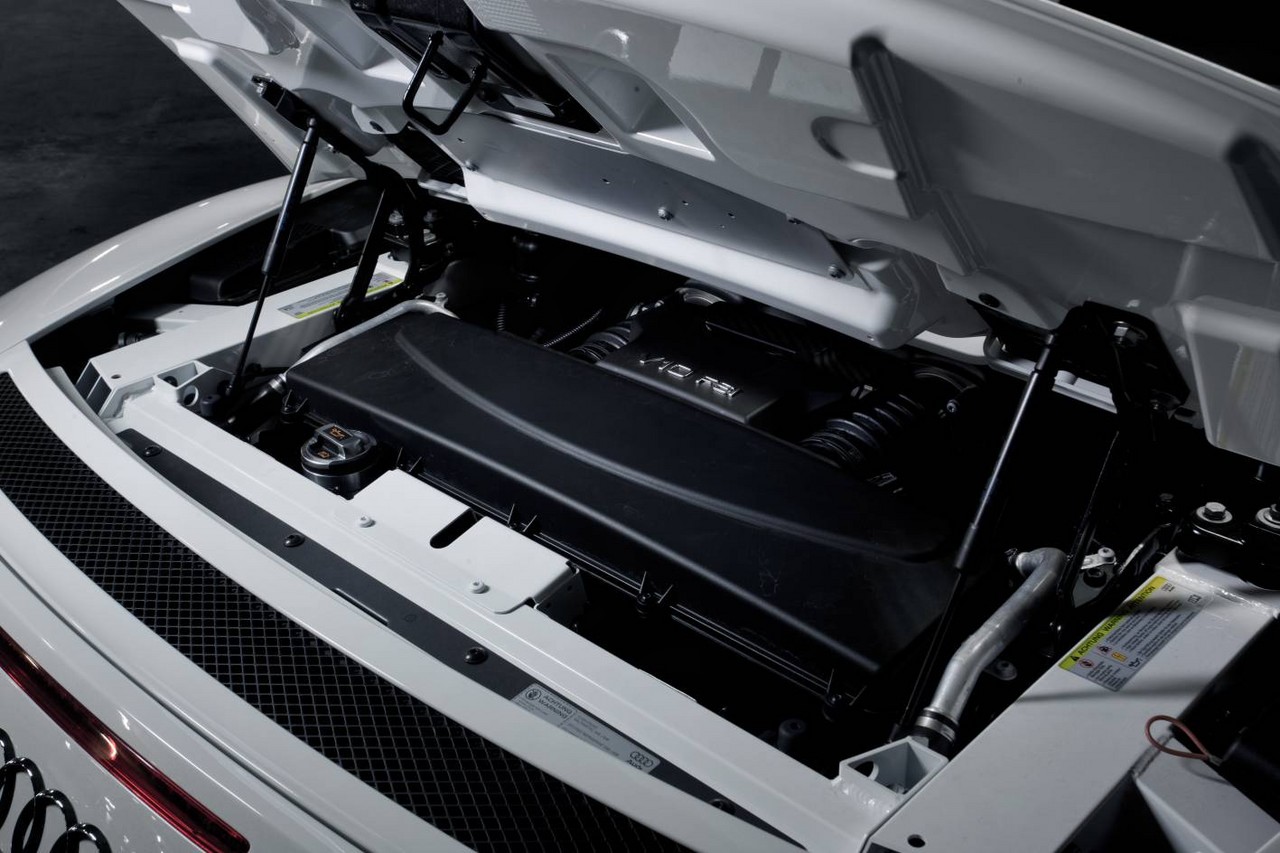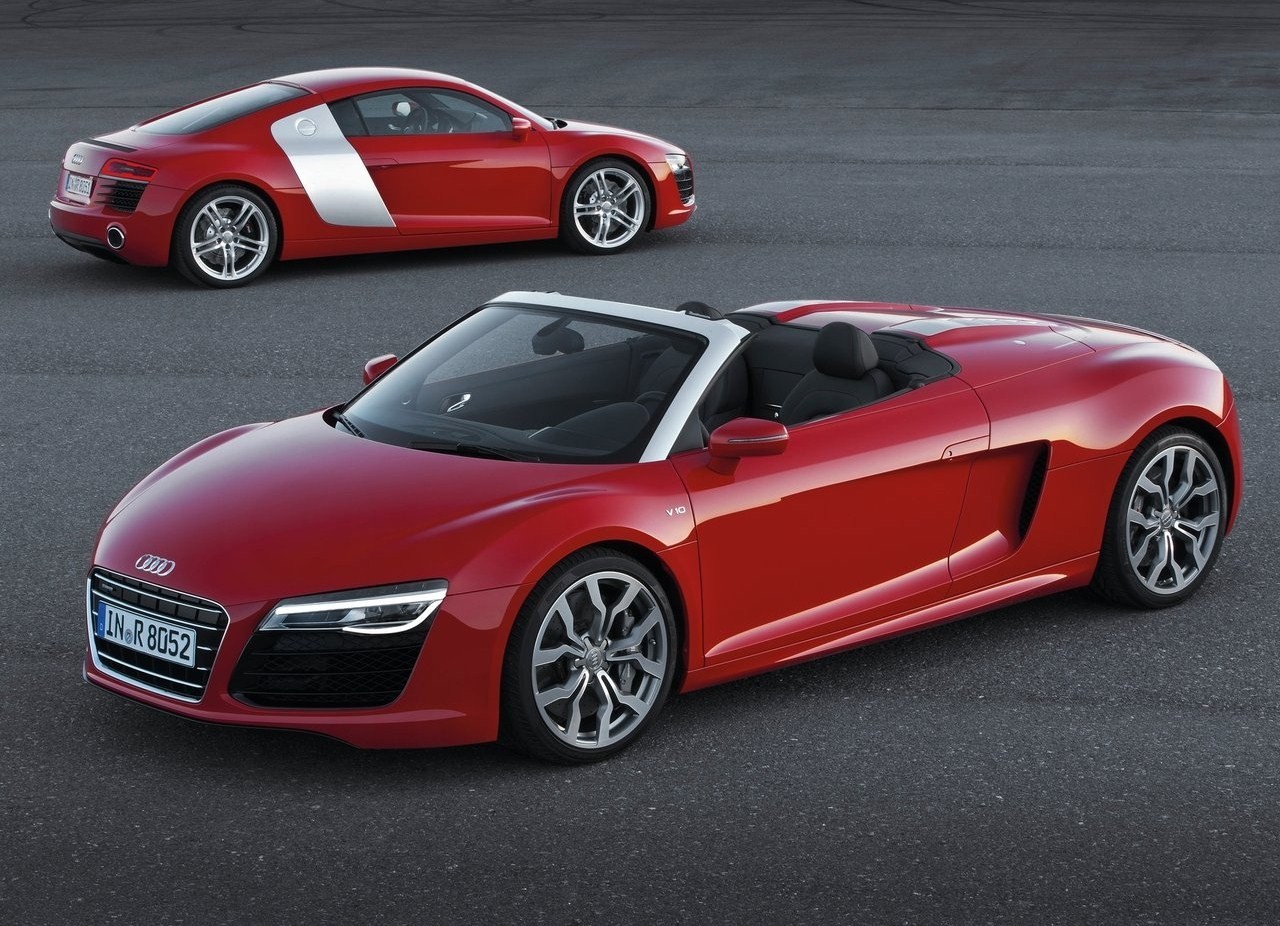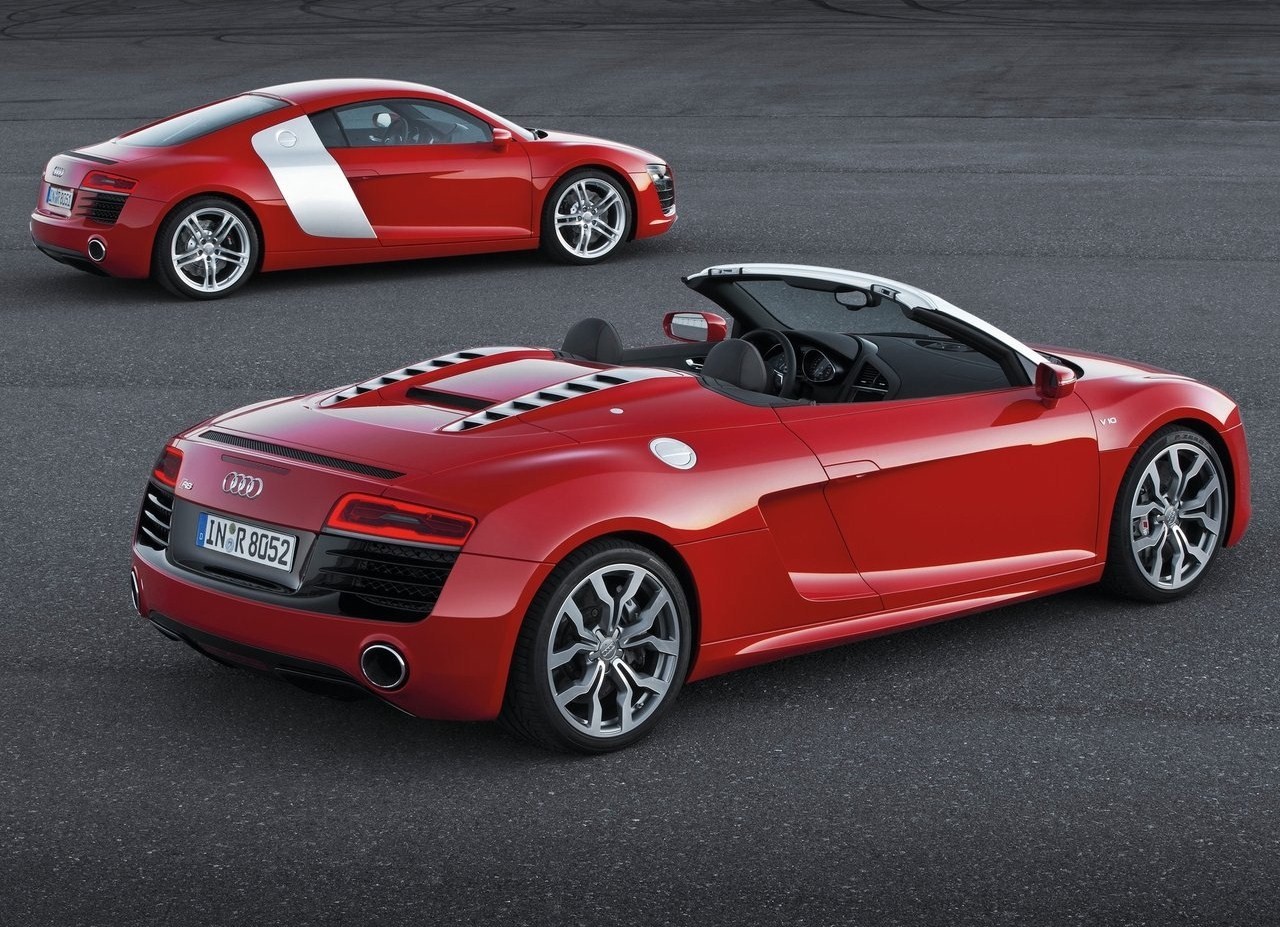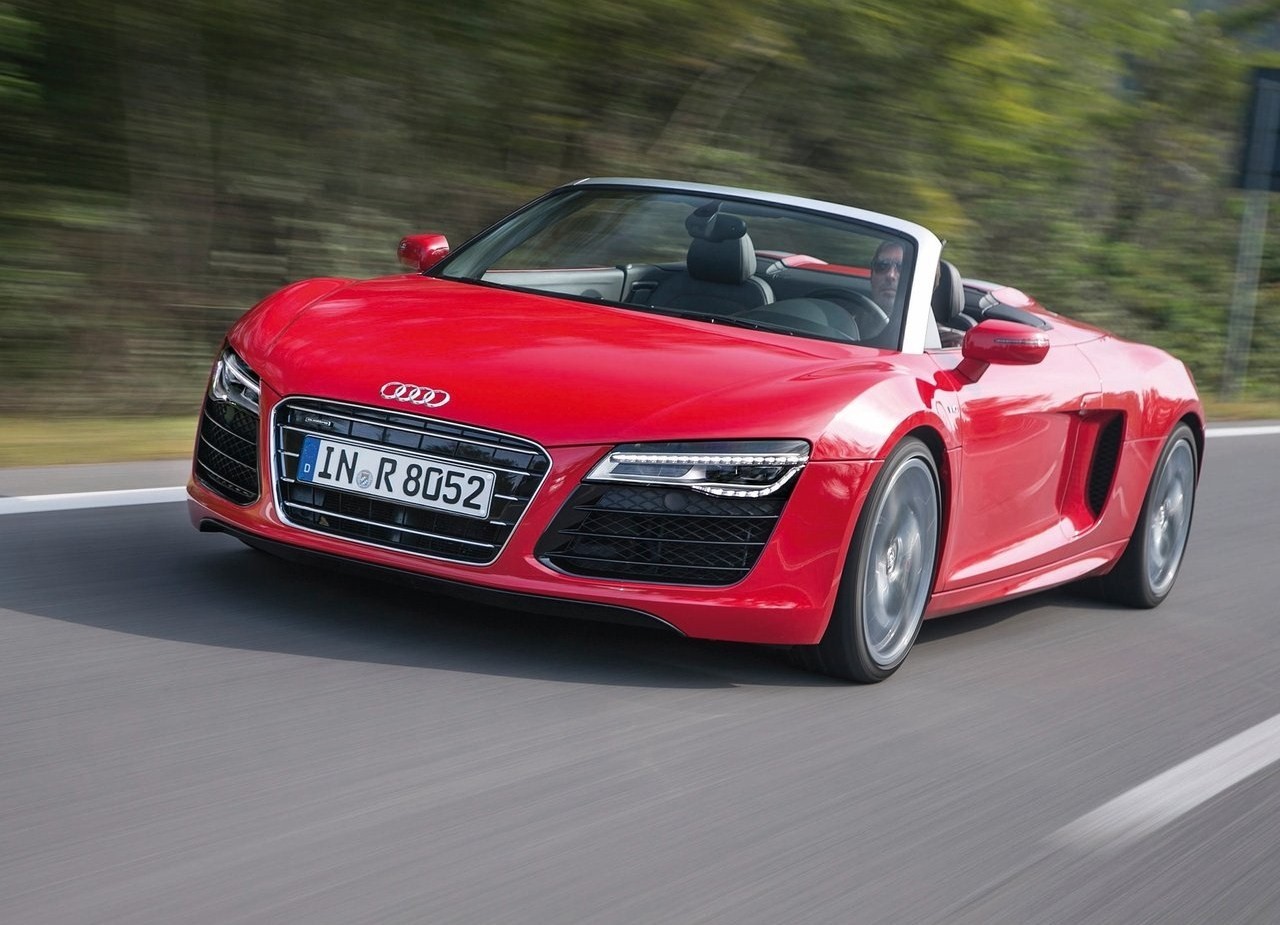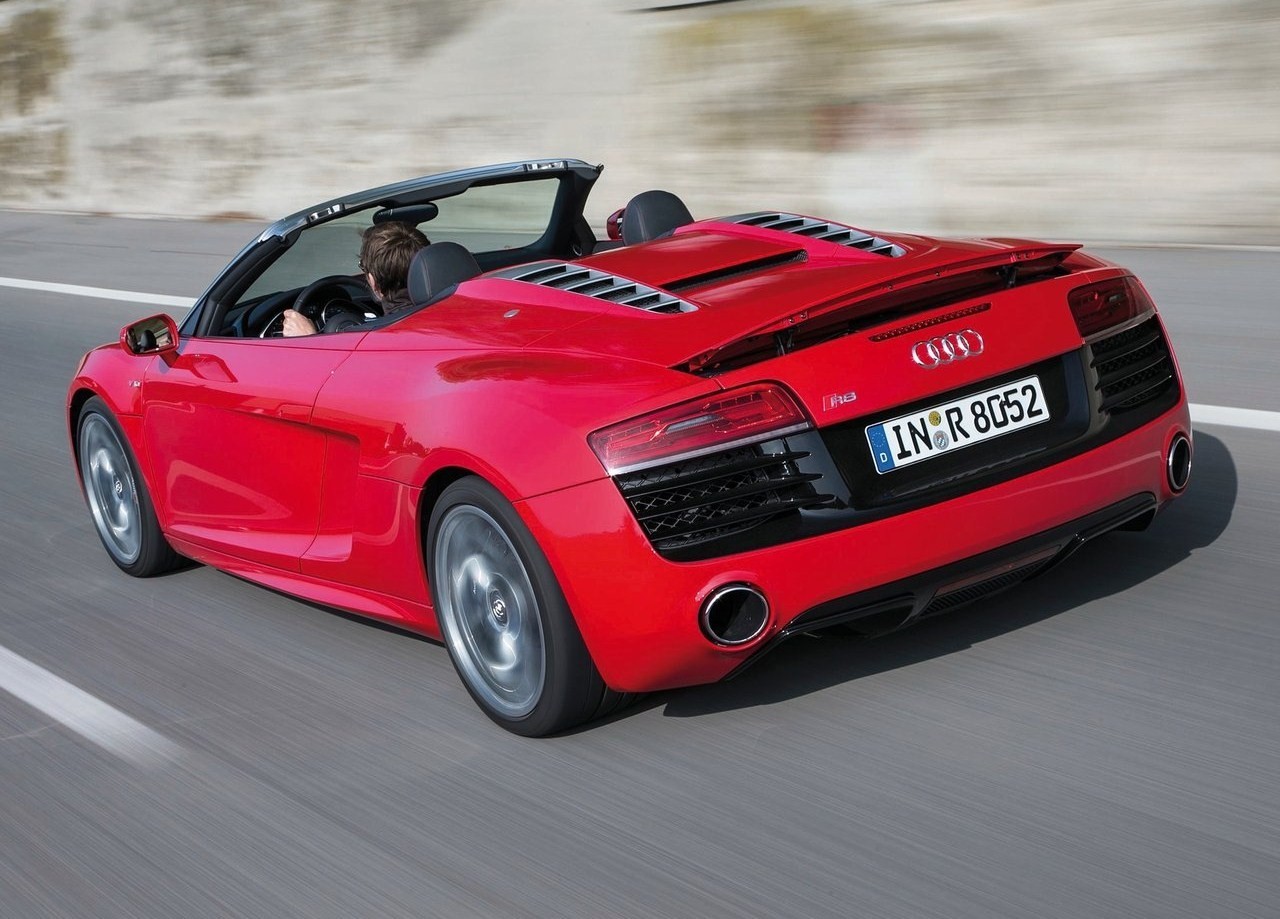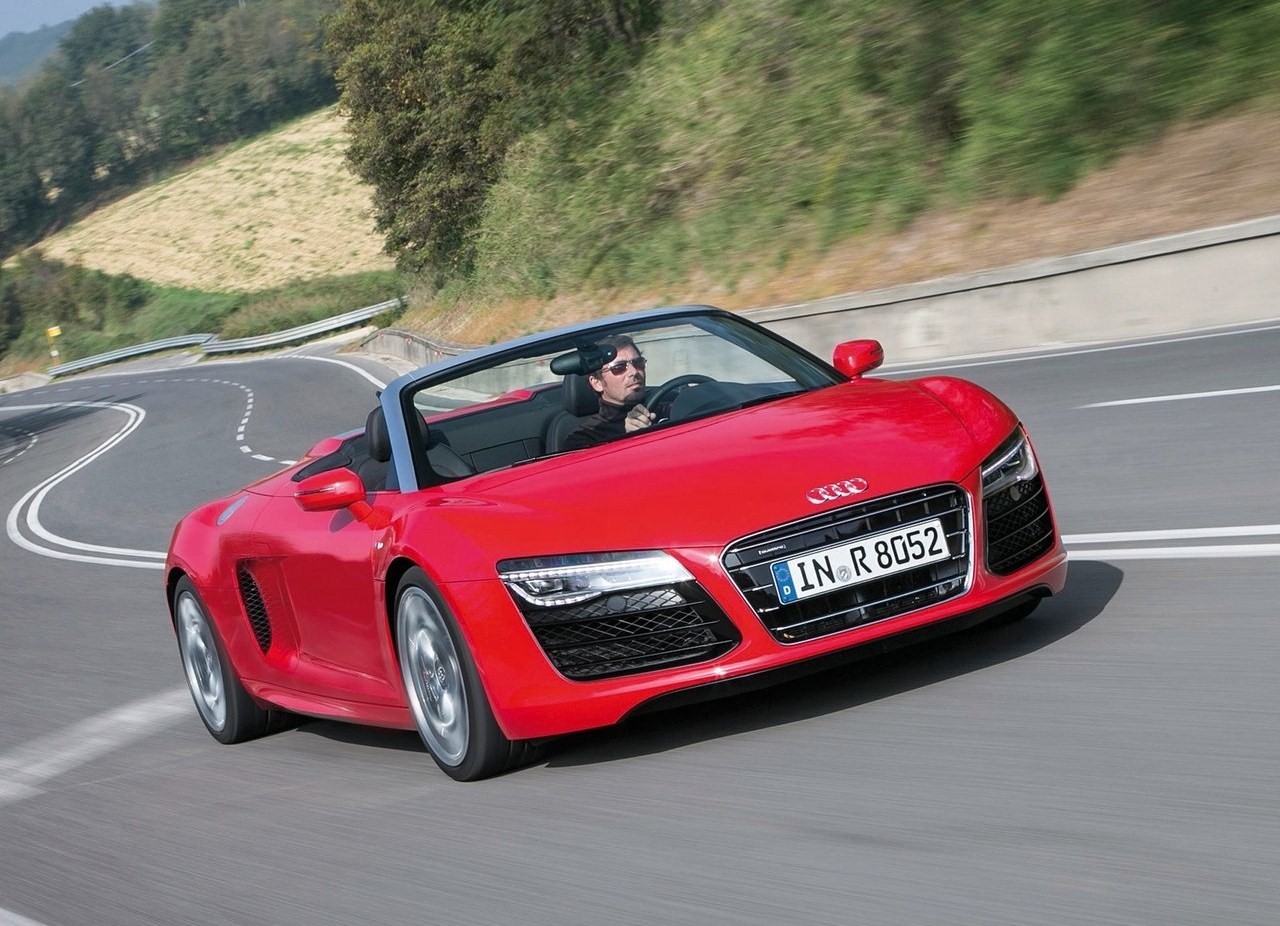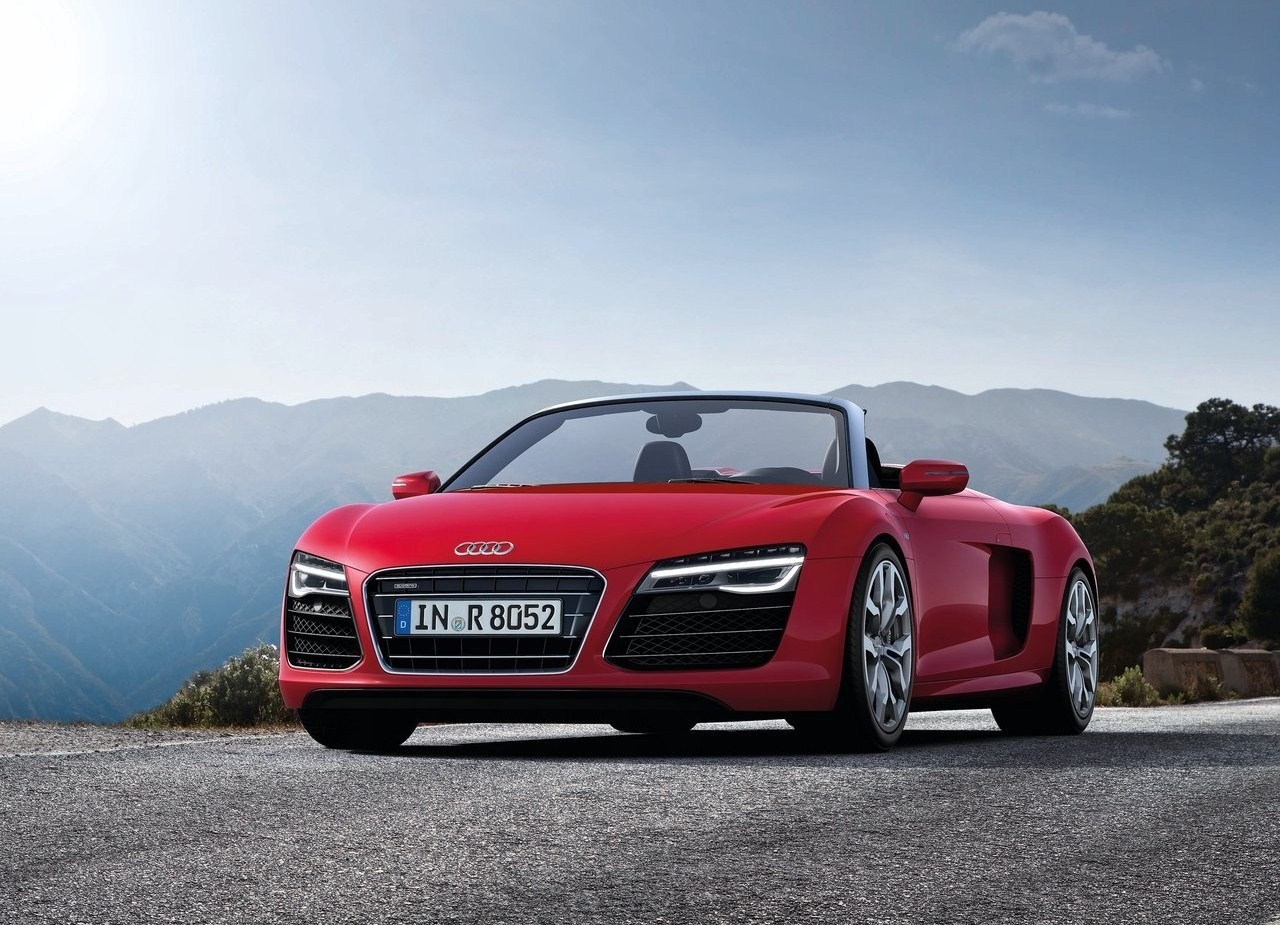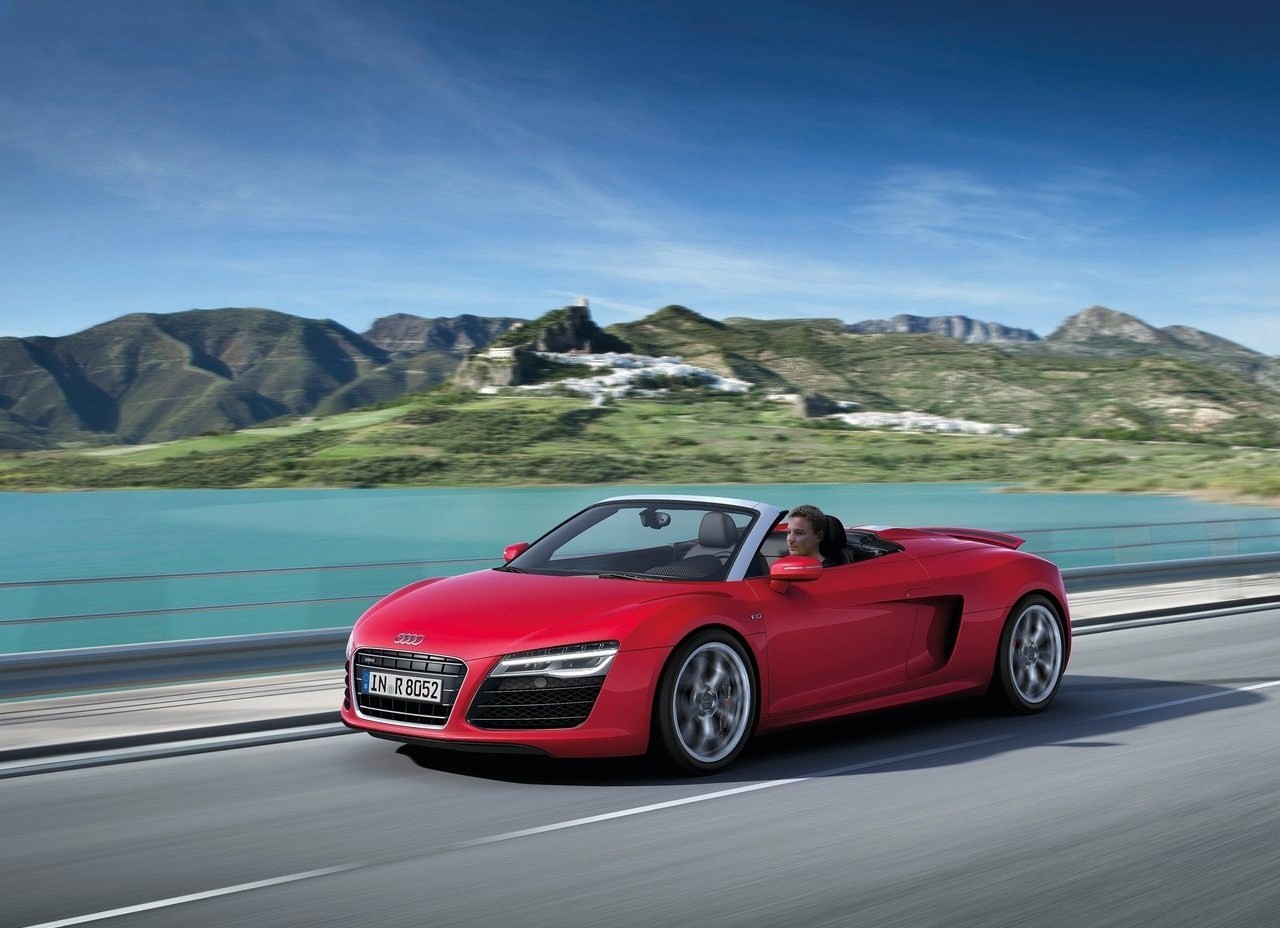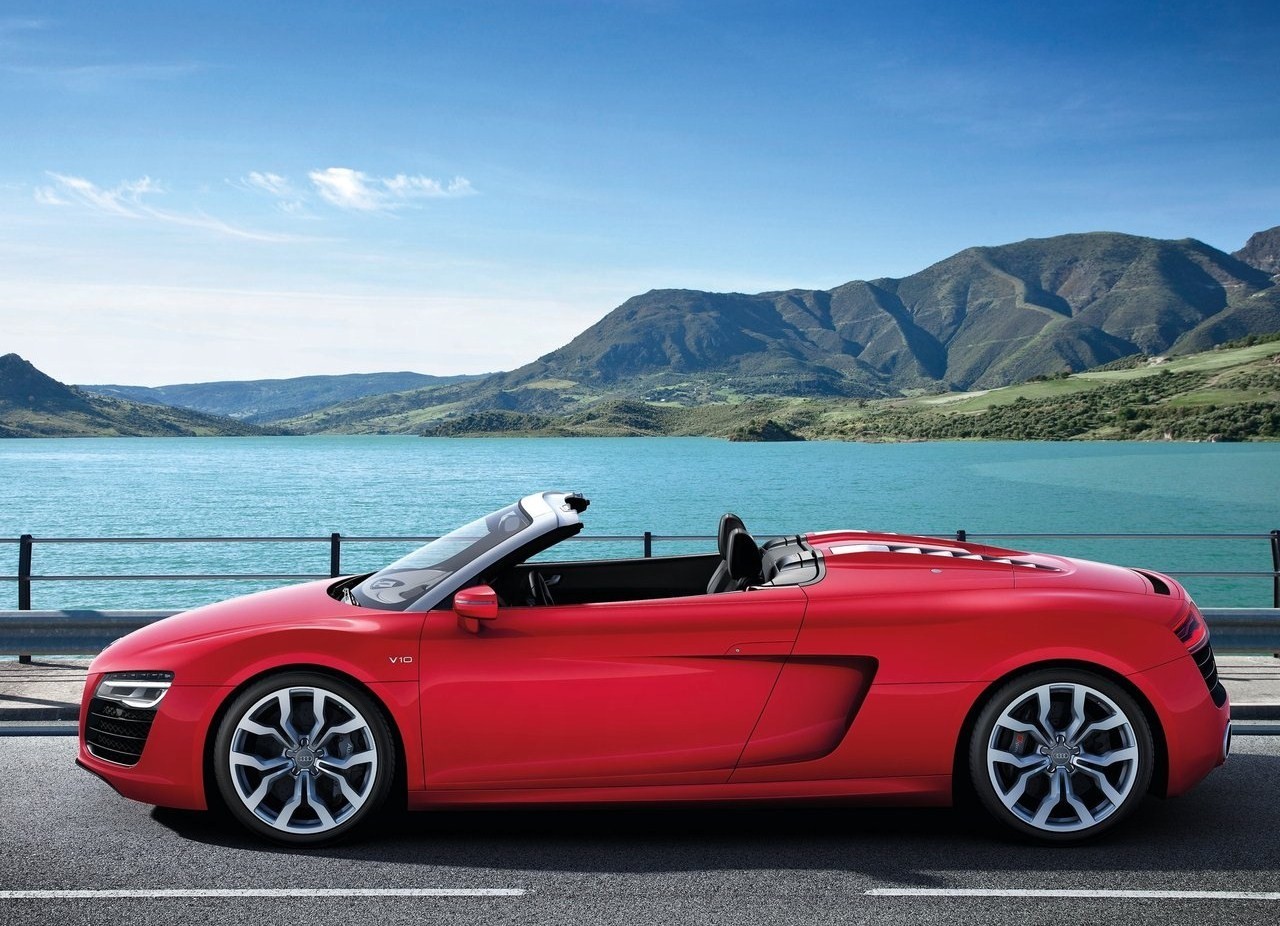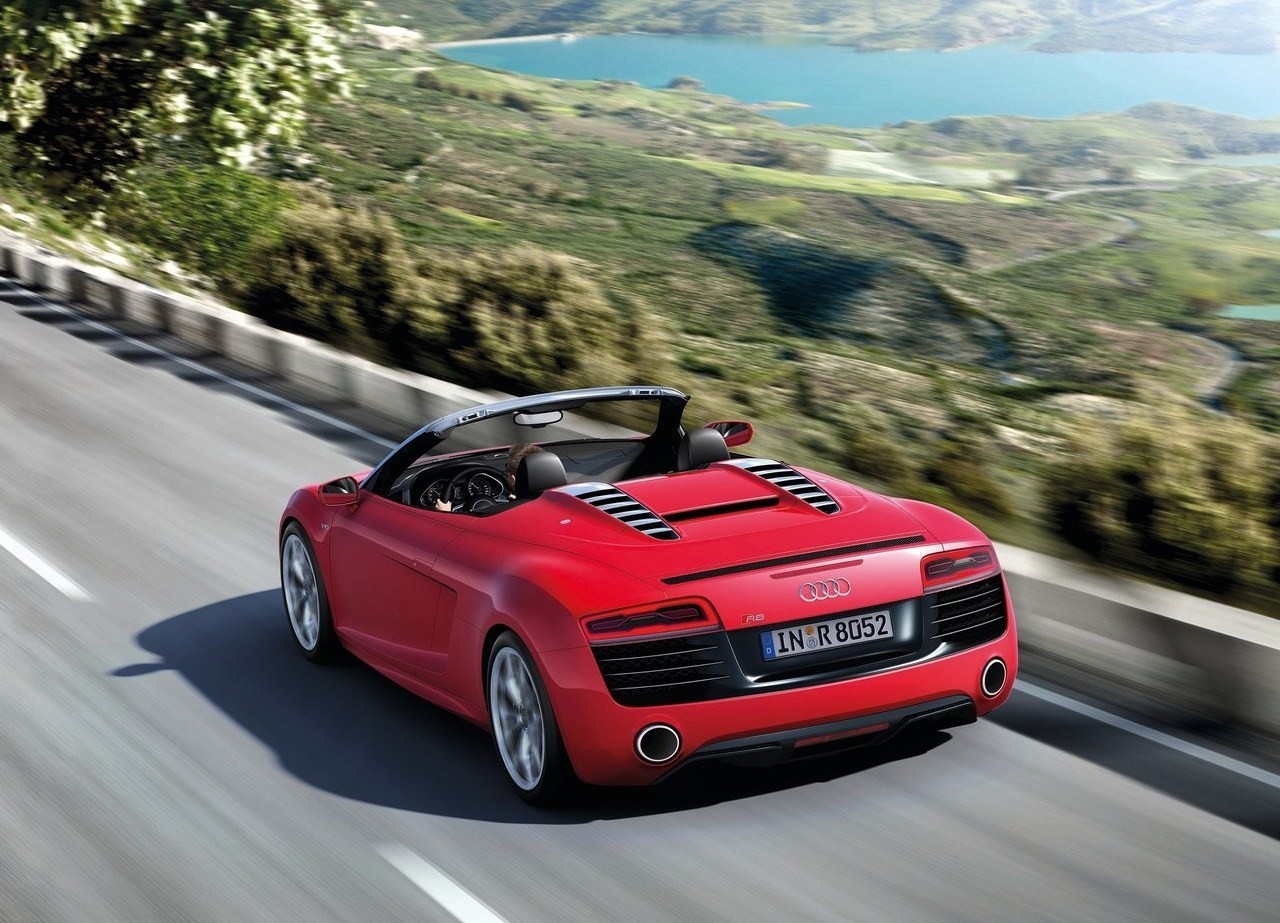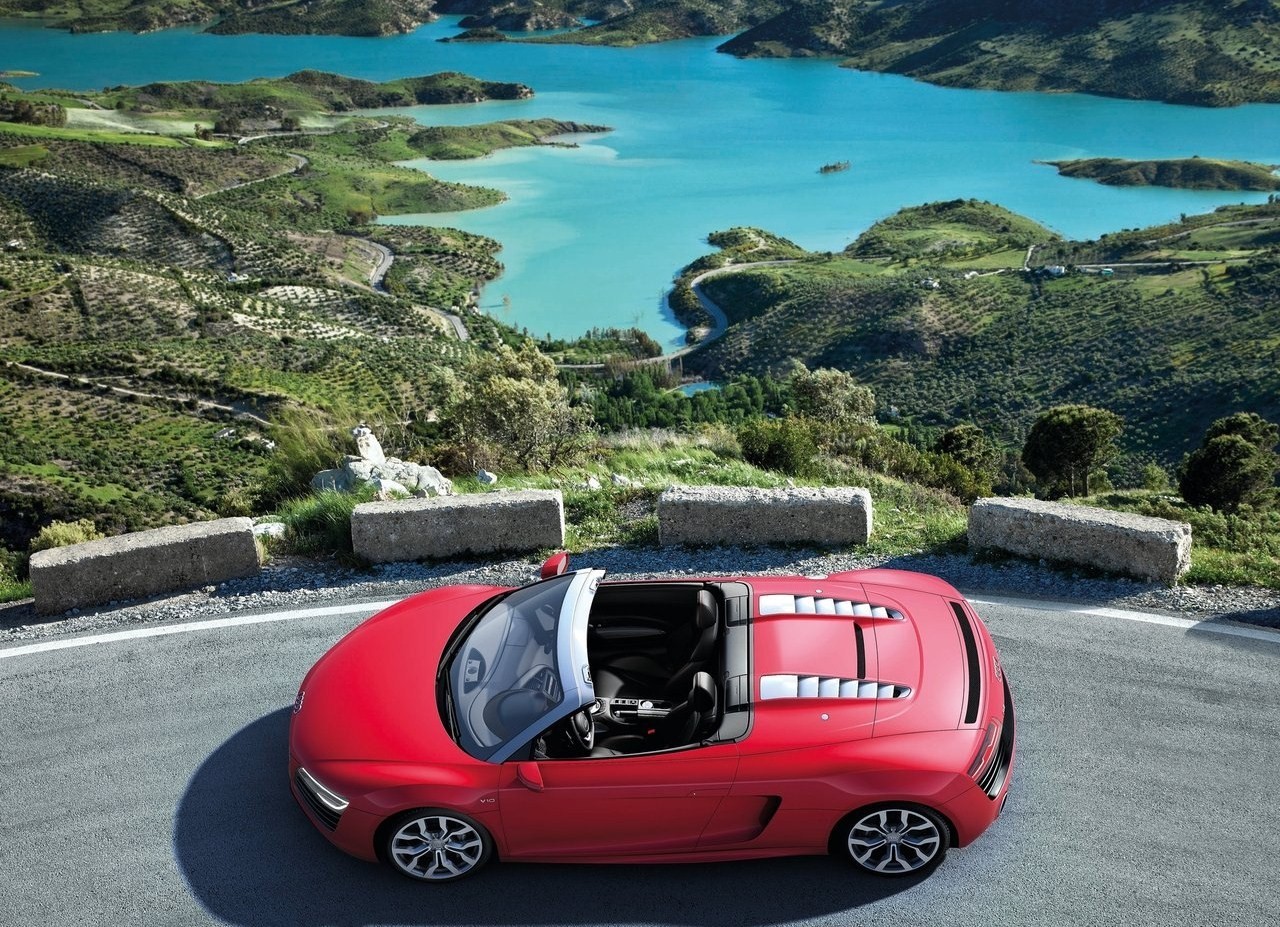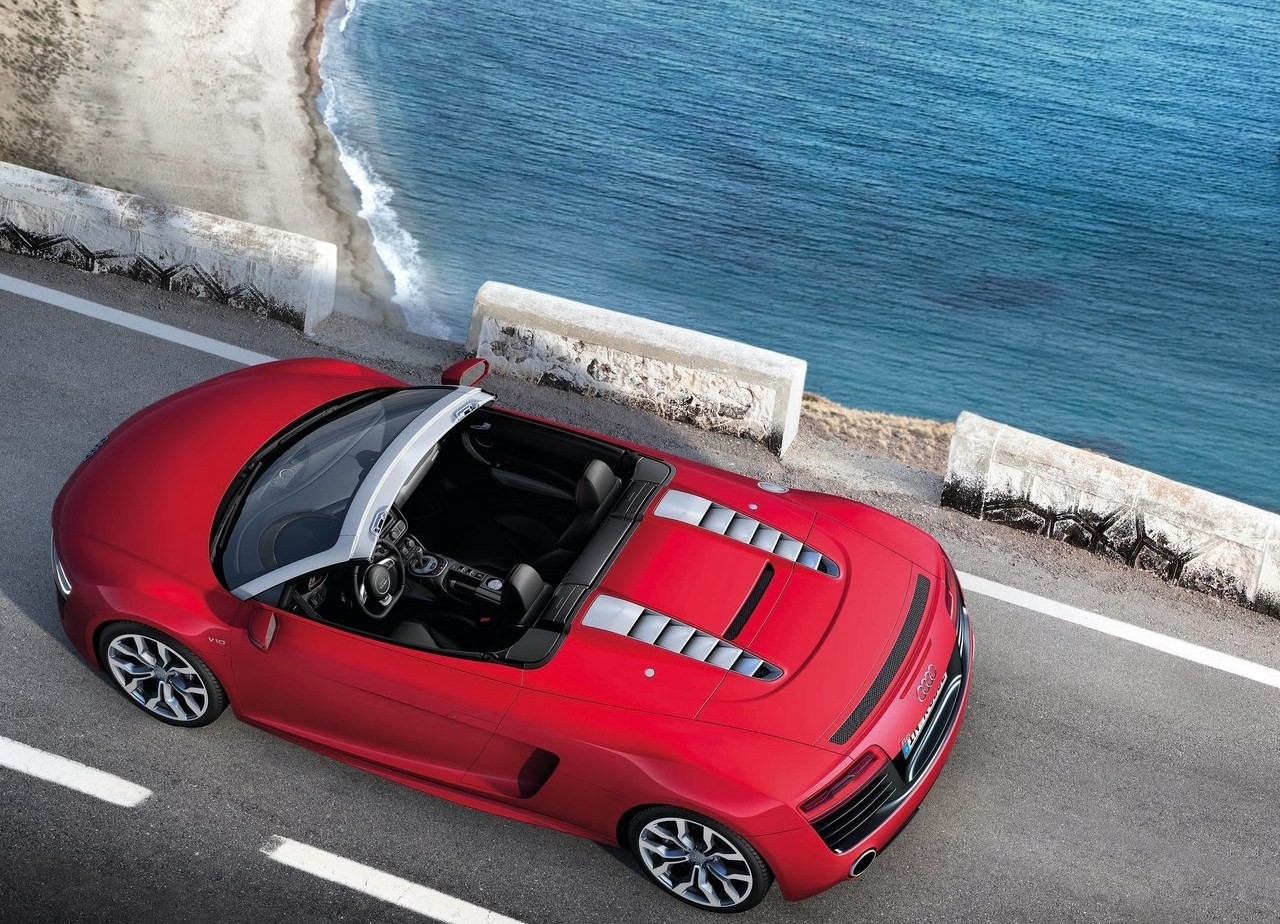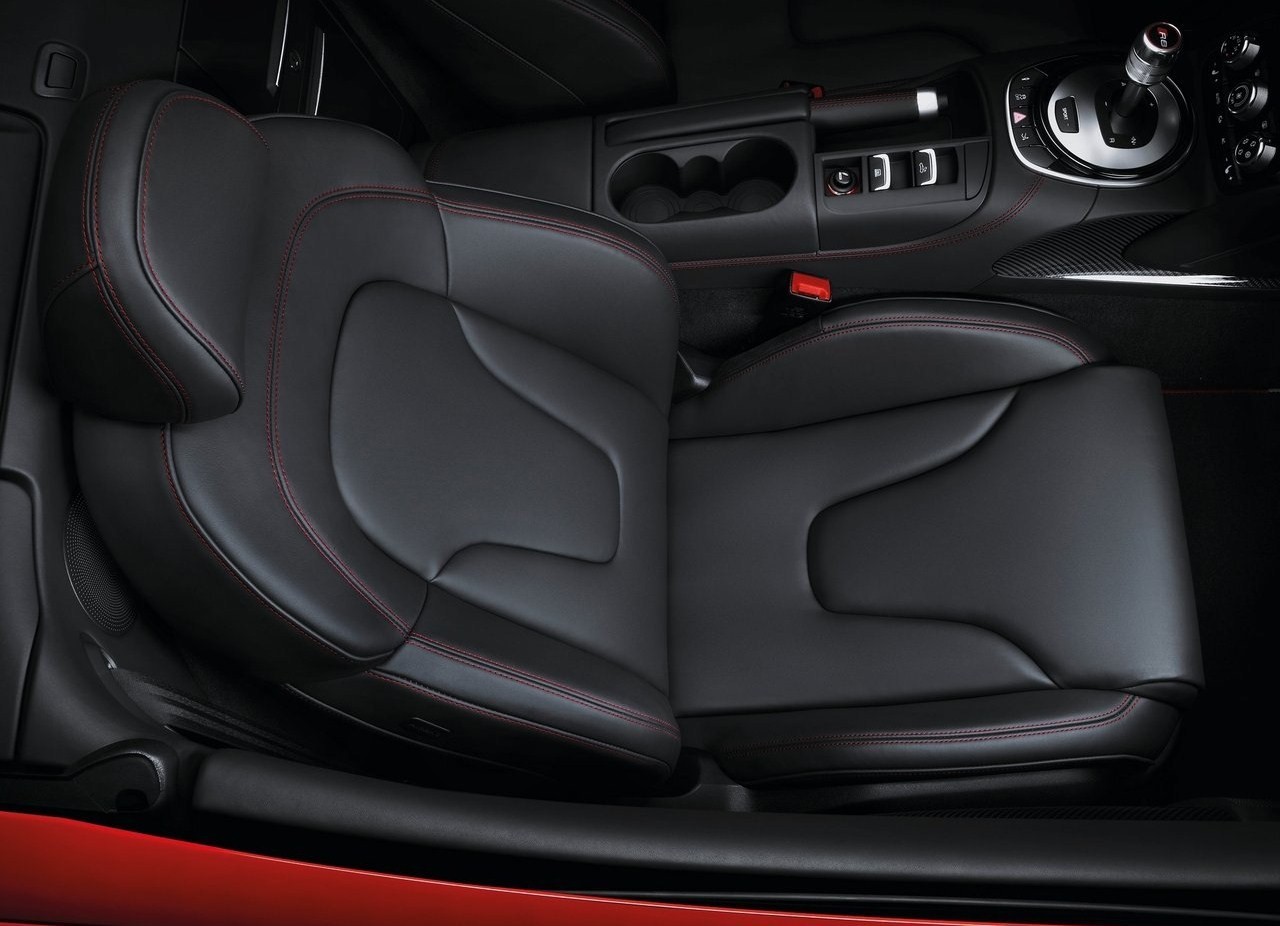
- Free-revving engines
- Traction from quattro system contributes to excellent dynamics
- S-Tronic transmission provides fast gearshifts
- For a supercar, surprisingly easy to drive
- Inferior performance and handling to Audi R8 Coupe
- Jerky Geartronic transmission
- Slow steering ratio
- Driving experience lacks feedback of Porsche 997 911 Cabriolet
Review: Audi R8 Spyder (2010-12)
Overview
Released in September 2010, the Audi R8 Spyder was a mid-engined, high performance convertible. Manufactured in Neckarsulm, Germany, the Audi R8 Spyder was initially available as a 5.2 FSI variant that was powered by a 5.2-litre V10 petrol engine – shared with the Lamborghini Gallardo LP560-4 – mated to either a six-speed manual or semi-automatic sequential transmission (Audi’s ‘R-Tronic’). In July 2012, the R8 Spyder range was expanded with the release of the 4.2 FSI variant.
4.2 FSI and 5.2 FSI V8 engines
Both the 4.2- and 5.2-litre engines featured direct injection, double overhead camshafts per cylinder bank, four valves per cylinder, continuous variable valve timing for intake and exhaust camshafts and had compression ratios of 12.5:1.
| Variant | Years | Engine | Trans. | Peak power | Peak torque |
|---|---|---|---|---|---|
| V8 | 2012 | 4.2-litre CNDA petrol V8 | 6sp semi-auto, 6sp man. |
316 kW at 7900 rpm | 430 Nm at 4500-6000 rpm |
| V10 | 2010-12 | 5.2-litre BUJ petrol V10 | 6sp semi-auto, 6sp man. |
386 kW at 8000 rpm | 530 Nm at 6500 rpm |
Body and dimensions
Like the Audi R8 Coupe on which it was based, the R8 Spyder was developed by Audi AG’s high performance subsidiary, quattro GmbH, and utilised the Lamborghini Gallardo platform. As such, the R8 Spyder had an aluminium monocoque chassis which used space frame construction principles such that the bodyshell weighed only 216 kg. Compared to the R8 coupe, the R8 Spyder was 3 mm longer (at 4434 mm), the same width (1904 mm), 8 mm lower (1244 mm) and had the same length wheelbase (2650 mm).
The R8 Spyder’s electro-hydraulic fabric roof could open or close in 19 seconds, and at speeds of up to 50 km/h. Furthermore, the heated rear window could be raised or lowered independently, enabling it to act as a wind-blocked if desired.
Suspension
Like the R8 coupe, the R8 Spyder had double wishbone front and rear suspension and was fitted with Audi’s ‘Magnetic Ride Control’ system whereby the dampers were filled with magnetorheological fluid and the application of a magnetic field could vary the suspension’s resistance.
quattro
The R8 Spyder’s ‘quattro’ all-wheel drive system consisted of a viscous coupling in the front axle housing. In normal conditions, the front:rear torque split was 15:85, but up to 35 per cent of the engine’s torque could be directed to the front axle if required. The R8 Spyder was also fitted with a rear electronic differential lock which could brake a spinning wheel to transfer torque to the opposing rear wheel (i.e. cross-axle torque transfer).
Safety equipment
Standard safety equipment for the Audi R8 Spyder included dual front airbags, front side airbags, ABS, electronic brake force distribution, brake assist, electronic stability control, traction control and front seatbelts with pretensioners and load limiters.
Brakes
The Audi R8 Spuder had ventilated and perforated 365 mm front brake discs with eight-piston calipers and 356 mm rear discs with four-piston rear calipers.
Features
Standard features for the Audi R8 Spyder included 19-inch alloy wheels with 235/35 front and 295/30 rear tyres, Multi Media Interface (Audi’s ‘MMI’) with a seven speaker sound system with a six-stack CD player, satellite navigation system and reversing camera, climate control air conditioning, leather seat trim, power adjustable seats, cruise control, LED headlights and driving lights, Bluetooth connectivity, reverse parking sensors, automatic headlights, rain-sensing wipers, a leather-wrapped steering wheel, remote central locking with proximity key, power windows and heated mirrors, tilt and telescopic steering wheel adjustment, an electrochromatic rear view mirror, a trip computer, an alarm and immobiliser.
The Aydu R8 Spyder V10 was fitted with a twelve speaker, 465 watt Bang & Olufsen sound system with a ten-channel amplifier, Fine Nappa leather upholstery, heated seats, power folding mirrors and tyre pressure monitoring. Models with the R-Tronic transmission were also fitted with steering wheel gearshift paddles.
R8 Spyder 5.2 FSI Carbon Edition
In December 2011, the R8 Spyder 5.2 FSI Carbon Edition was released. Compared to the standard R8 Spyder, the Carbon Edition was fitted with carbon-fibre ‘side blade’ inlays, door mirrors, front lip spoiler, rear diffuser and illuminated sill plates. The Carbon Edition was also distinguished by its titanium-finished 19-inch double-spoke alloy wheels and gloss black grille and matte-black window surrounds.
Review: Audi R8 Spyder (2013-15)
Overview
Released in March 2013, the 2013 Audi R8 Spyder introduced seven-speed double clutch transmissions (Audi’s ‘S-Tronic’) and subtle cosmetic updates. Visually, the 2013 R8 Spyder could be identified by its standard LED headlights, new rear indicator lights, single frame grille with beveled upper corners (and painted high-gloss black) and new front bumper.
The seven-speed double-clutch transmission utilised two multi-plate clutches – positioned behind one another – which served two mutually independent sub-transmissions. As a result, gears were shifted directly as the clutches alternately opened and closed.
| Variant | Years | Engine | Trans. | Peak power | Peak torque |
|---|---|---|---|---|---|
| V8 | 2013-15 | 4.2-litre CNDA petrol V8 | 6sp man., 7sp DCT |
316 kW at 7900 rpm | 430 Nm at 4500-6000 rpm |
| V10 | 2013-15 | 5.2-litre BUJ petrol V10 | 7sp DCT | 386 kW at 8000 rpm | 530 Nm at 6500 rpm |
Features
Standard features for the 2013 R8 Spyder were extended to include LED headlights and Fine Nappa leather upholstery.
Related links
